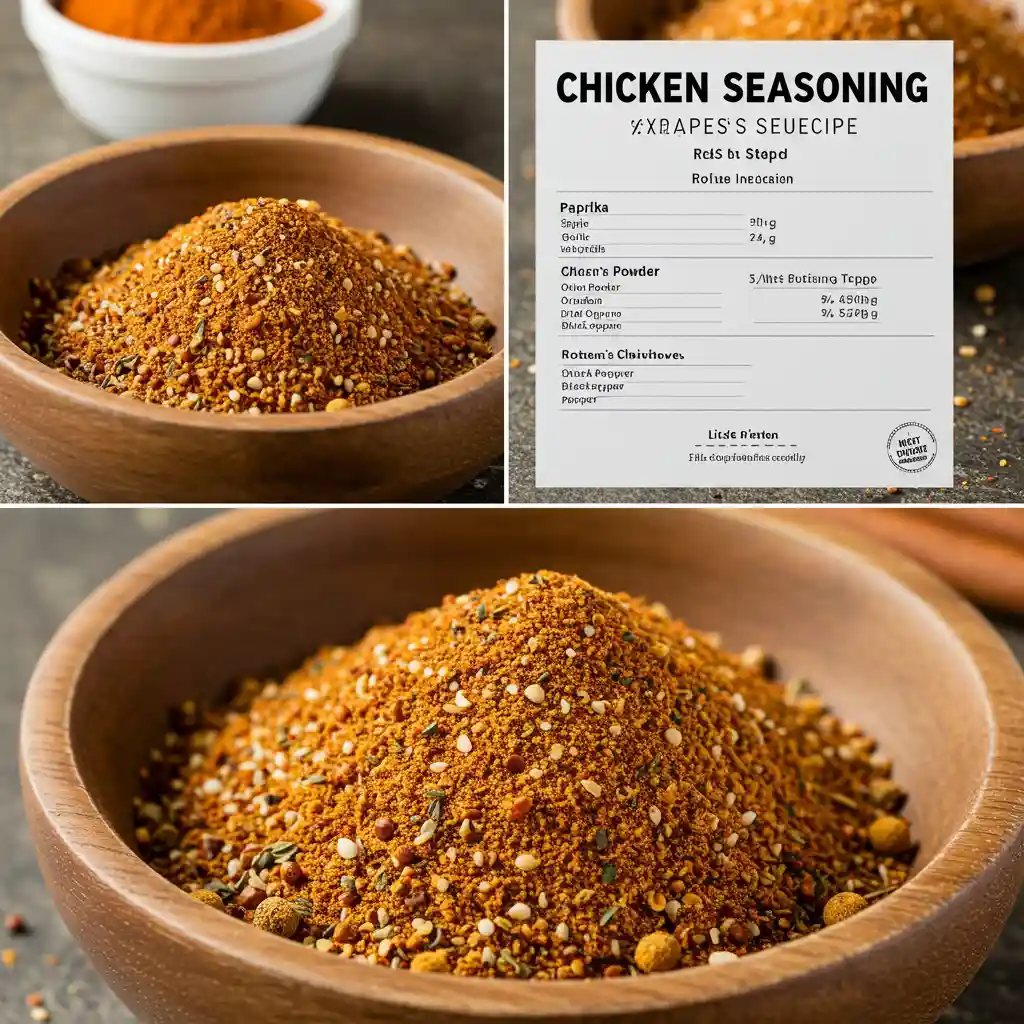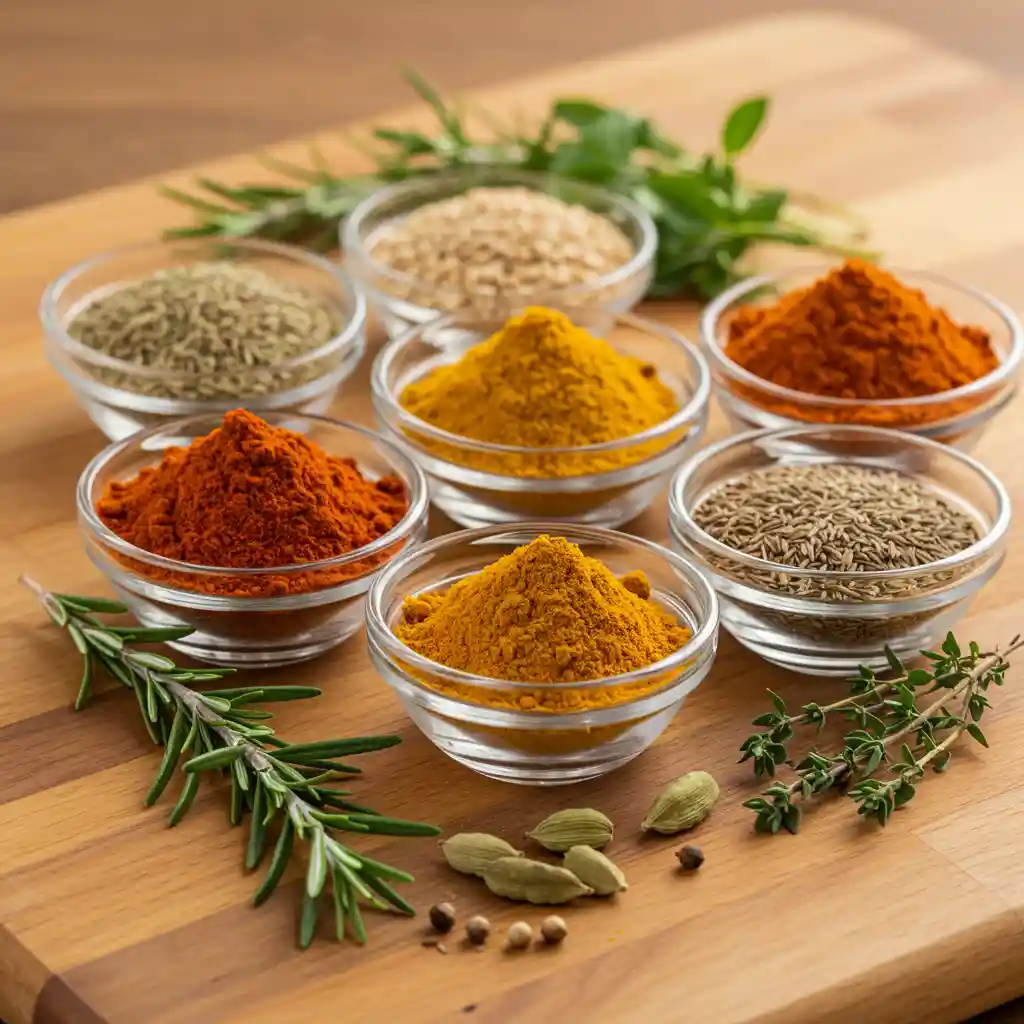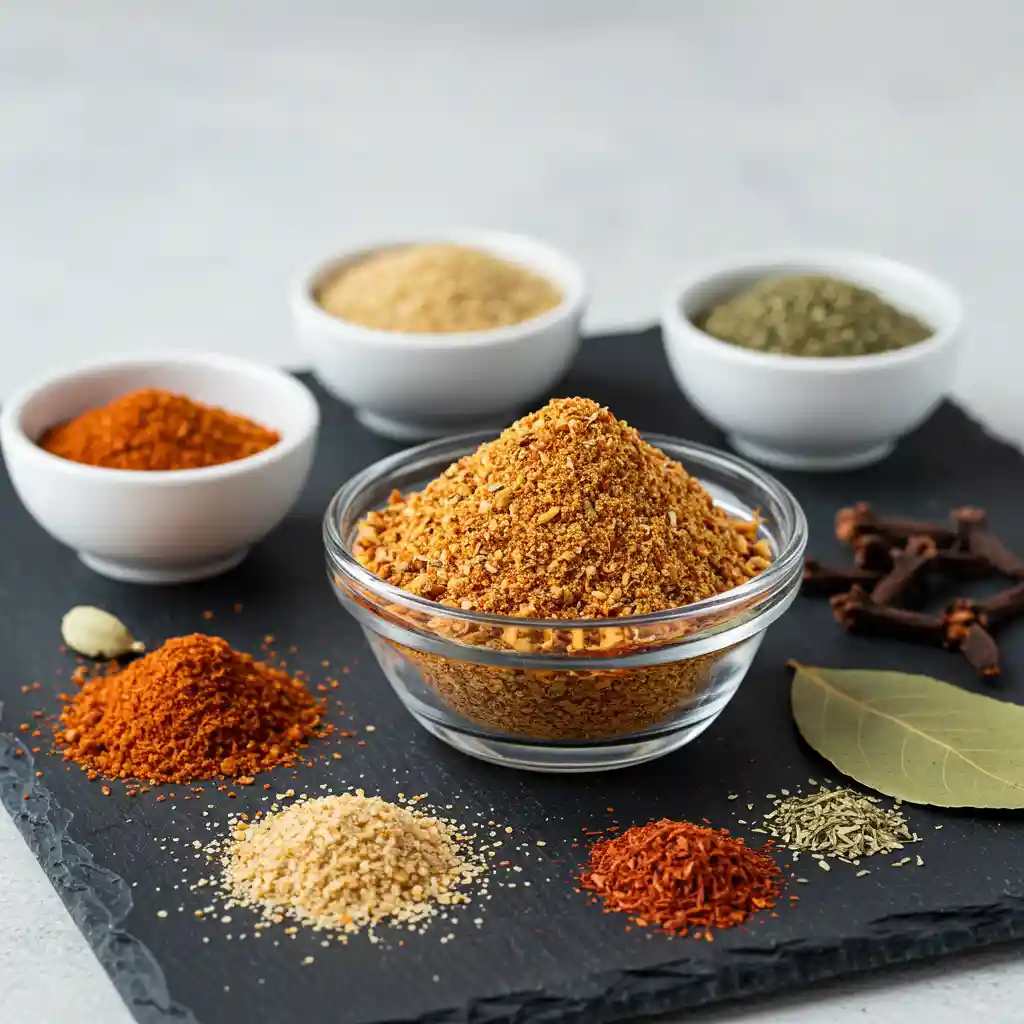Creating the perfect chicken seasoning can elevate any chicken dish from ordinary to extraordinary. A simple chicken seasoning can completely enhance the flavor of chicken breasts, thighs, or even an entire bird into a flavorful masterpiece. This article will guide you through the essentials of chicken seasoning, how to make your rub, and provide tips for using it in various cooking methods.
Table of Contents
What is the Best Chicken Seasoning?
Understanding Chicken Seasoning Blends
Chicken seasoning blends are combinations of herbs and spices designed to enhance chicken flavor. TTop chicken seasoning blends usually strike a balance between salt, pepper, sweetness, and spice. spice to complement the natural taste of the meat. A well-crafted chicken seasoning blend can include ingredients like paprika, garlic powder, onion powder, and cayenne pepper. Understanding these components helps you appreciate how they interact with chicken, whether you’re grilling, baking, or frying. Each blend can suit different cooking styles and personal preferences, making chicken seasoning a versatile tool in any kitchen.
These blends are not just random assortments; they’re carefully curated homemade spice blends to create the best flavor profile for chicken dishes. By exploring various chicken seasoning recipes, you can discover how spices like chili powder and black pepper can add depth and warmth, enhancing your chicken spice repertoire. Additionally, recognizing the role of each herb and spice allows for customization, ensuring that your chicken rub aligns perfectly with your culinary vision. Ultimately, becoming skilled at mixing chicken seasonings will boost your confidence to try out new flavor combinations. with flavors, creating dishes that are both delicious and memorable, like great chicken wings or homemade chicken nuggets.
Key Ingredients for a Flavorful Chicken Rub
The key ingredients for a flavorful chicken rub typically include a mix of herbs and spices that work harmoniously together, making it perfect for seasoning chicken wings. Key ingredients typically include salt, black pepper, paprika, garlic powder, and onion powder, all working together to build flavor.l of which contribute to a well-rounded seasoning for chicken. Additionally, spices like cayenne pepper or chili powder can add a kick, enhancing the overall taste profile. A good chicken rub strikes a balance between savory, spicy, and aromatic elements, ensuring each bite is packed with flavor.
Whether you’re cooking on the grill, baking in the oven, or air frying.
How to Choose the Right Spice Mix for Chicken
Choosing the right spice mix for chicken depends on the cooking method and personal taste preferences. For grilling, a robust blend that includes paprika, garlic powder, and cayenne can help create a delicious crust on grilled chicken. If you’re roasting chicken, a more mellow combination featuring herbs like thyme and rosemary may be ideal. It’s essential to consider the cut of chicken as well; chicken thighs benefit from more intense flavors, while chicken breast may require a lighter touch. Understanding these nuances ensures that your chicken seasoning accurately complements the dish, enhancing the flavor to meat in every recipe.
When selecting a spice mix for chicken, think about the overall flavor profile you wish to achieve. For example, if you’re preparing a classic barbecue dish, a sweet and smoky seasoning mix would be appropriate, perfect for seasoning chicken wings. Conversely, if you’re looking for a spicy kick, a mix with cayenne and chili powder would do the trick. Experimenting with different spice blends can lead to delightful discoveries, allowing you to create unique chicken recipes that impress family and friends alike. Ultimately, the right chicken seasoning will enhance the natural flavors of the meat, making every meal a culinary delight.

How to Make an Easy Chicken Rub?
Step-by-Step Guide to Homemade Chicken Seasoning
Making an easy chicken rub is a straightforward process that requires just a few ingredients. Begin by selecting your desired spices and herbs, such as paprika, garlic powder, onion powder, and cayenne pepper. Using a small bowl, combine these ingredients in proportions that appeal to your taste. A helpful guideline is to use one tablespoon of the spice blend for each pound of chicken. Whisk the spices together to ensure an even distribution before applying it to your chicken. This process not only allows for customization but also ensures that your chicken is evenly seasoned.
Once you have your spice blend ready, the application is key to achieving the best flavor. Rub the seasoning into the chicken, ensuring that all surfaces are coated. For optimal results, allow the seasoned chicken to marinate for at least 30 minutes, or longer if possible, to enhance the flavor of the herb or spice blend. This resting period helps the spices penetrate the meat, enhancing the overall flavor profile, which is crucial for the best homemade chicken nuggets. By following these simple steps, you can create a delicious homemade chicken seasoning that elevates Any chicken recipe, turning it into a memorable and flavorful meal.
Essential Herbs and Spices for Chicken Rub Recipe
An effective chicken rub recipe incorporates a variety of essential herbs and spices that work together to enhance the meat’s flavor. Common ingredients include salt, black pepper, paprika, garlic powder, and onion powder, all of which create a savory base. To add complexity, consider incorporating cayenne pepper for heat or brown sugar for a touch of sweetness, both of which can come from your spice drawer. These ingredients not only enhance the taste but also provide aromatic qualities that can elevate your chicken dishes, particularly when using taco seasoning, making it the best homemade option for flavor to meat. Balancing these flavors is crucial for a well-rounded chicken rub, especially when it comes to great chicken dishes.
In addition to the basic spices, experimenting with other herbs can add a unique twist to your chicken rub. Herbs like dried thyme, oregano, and rosemary add earthy flavors that pair wonderfully with grilled or roasted chicken. The secret lies in achieving the right harmony between herbs and spices to develop a seasoning blend that suits your palate. By understanding the role of each ingredient, you can customize your easy chicken rub to match various cooking methods, ensuring that your chicken is always flavorful and satisfying, especially when using homemade spice blends. This personalization is what makes homemade chicken seasoning truly special.
Customizing Your Easy Chicken Rub
Customizing your easy chicken rub allows for endless possibilities in flavor combinations, making it great for seasoning chicken tenders. Start by experimenting with different ratios of the basic spice ingredients. For instance, if you prefer a spicier kick, increase the amount of cayenne pepper or chili powder in your chicken seasoning blend, especially if you’re making a big batch of chicken salad. Alternatively, if you enjoy a sweeter flavor profile, adding brown sugar can balance the spices. The beauty of a homemade chicken rub is that it can be tailored to suit individual preferences and match the specific dish you’re preparing.
Additionally, you can also explore regional flavors to create unique chicken seasoning mixes. For example, a Mediterranean-inspired rub might include dried oregano, lemon zest, and garlic powder, while a smoky BBQ seasoning rub could emphasize smoked paprika and brown sugar, creating unique flavor profiles per pound of meat. Feel free to experiment with different combinations—the aim is to craft a chicken seasoning that rub that enhances the meat while reflecting your taste. By customizing your seasoning, you’ll ensure that every chicken dish becomes a personal culinary experience that resonates with your flavor preferences.
What Are the Benefits of Using a Dry Rub?
Enhancing Flavor with a Chicken Dry Rub
Using a dry rub on chicken significantly enhances the flavor profile of the meat. The blend of spices and herbs forms a flavorful crust as it cooks, sealing in moisture and creating an irresistible outer layer. The crust adds a satisfying texture and helps the spices seep into the chicken as it cooks. Whether you’re roasting or grilling, using a dry rub guarantees bold flavor in every bite, taking your dish to the next level.
In addition, dry rubs can be a healthier choice compared to marinades, which frequently include added sugars. and fats. By opting for a dry rub, you can enjoy the best flavor without added calories. As the spices caramelize during cooking, they create a rich and savory taste that enhances the chicken’s natural flavors, making it perfect for keeping your whole rotisserie chicken delicious. This cooking method is particularly effective for lean cuts, such as chicken breast, where moisture retention is crucial. In the end, using a chicken dry rub is an excellent method to enhance flavor while still keeping things healthy. a healthier approach to cooking.
How Dry Rubs Improve Texture and Juiciness
Dry rubs enhance both the texture and moisture of chicken by forming a flavorful crust that seals in juices as it cooks. The spices act as a protective layer, helping the meat stay tender and moist. the natural juices within the meat. This is especially important for lean cuts, like chicken breast, which can easily dry out. The result is tender, juicy chicken that remains flavorful, even after cooking. In addition to moisture retention, the crust formed by the dry rub adds an appealing A crisp outer layer that pairs perfectly with the tender texture of the meatDry rubs enhance both the texture and moisture of chicken by forming a flavorful crust that seals in juices as it cooks. The spices act as a protective layer, helping the meat stay tender and moist. the natural juices within the meat. This is especially important for lean cuts, like chicken breast, which can easily dry out. The result is tender, juicy chicken that remains flavorful, even after cooking. In addition to moisture retention, the crust formed by the dry rub adds an appealing a crisp outer layer that pairs perfectly with the tender texture of the meat.
Additionally, the blend of heat and spices in the rub elevates the entire dining experience.experience, making each bite more enjoyable. The Maillard reaction occurs during cooking, where proteins and sugars react to create complex flavors and aromas. This process is amplified by the use of a dry rub, making your chicken not only juicy but also rich in savory notes. Whether you’re grilling, baking, or air frying, a well-seasoned chicken rub will elevate your dish, Making sure every bite is tender and full of flavor. This technique is an excellent way to impress guests with your culinary skills.
Comparing Dry Rub vs. Marinade for Chicken
When comparing dry rubs to marinades, each method has its unique benefits and applications. Dry rubs provide a concentrated flavor on the surface of the chicken, forming a flavorful crust that enhances texture and juiciness. In contrast, marinades penetrate the meat, often utilizing acidic elements like vinegar or citrus juice to tenderize. While marinades can impart flavor deep within the meat, they may also introduce additional moisture, which can alter the cooking process. Understanding these differences helps in deciding which method to use based on the desired outcome.
For instance, if you’re looking for a quick flavor boost, a dry rub is the way to go. It requires minimal prep time and can be applied just before cooking. On the other hand, if you have time to let the chicken soak in a marinade, this method can yield deliciously tender results, especially when you cook chicken with a great seasoning blend. In the end, deciding between a dry rub and a marinade comes down to individual taste and the specific chicken recipes you’re preparing. Whichever method you choose, both can result in flavorful chicken dishes that are perfect for keeping your family satisfied. mouthwatering chicken dishes when executed correctly.

What Makes a Chicken Seasoning Recipe the Best?
Balancing Flavors: Salt, Sweet, and Spice
The best chicken seasoning recipes achieve a harmonious balance of flavors, combining salt, sweet, and spice to create an unforgettable taste experience. Salt enhances the natural flavors of the chicken, while sweet elements such as brown sugar or honey can provide a delightful contrast. Spicy components, like cayenne or black pepper, add depth and excitement to the seasoning. Striking the right balance between these elements is essential for a chicken rub that elevates your dish and satisfies diverse palates.
To master this balance, it’s important to experiment with varying proportions of each flavor. Start with a basic recipe, then adjust the saltiness, sweetness, and spiciness according to your Preferences, offering an ideal method to enhance the taste of meat. For example, if you prefer a sweeter rub, consider increasing the sugar content slightly, while ensuring it remains balanced with salt and spice. This careful attention to flavor balance ensures that your chicken seasoning not only enhances the meat but also complements any side dishes you serve, adding flavor to chicken. Ultimately, the best chicken seasoning recipes result in a well-rounded flavor profile that keeps diners coming back for more.
Popular Ingredients in Best Chicken Seasoning Recipes
Some popular ingredients in the best chicken seasoning recipes include garlic powder, onion powder, paprika, cayenne pepper, and various dried herbs. These ingredients create a robust flavor foundation that can be tailored to suit different cooking styles and personal tastes. Garlic powder and onion powder add savory notes, while paprika provides both color and sweetness. Cayenne pepper introduces heat, ensuring that your chicken rub has a little kick. Furthermore, herbs like thyme, oregano, and basil can enhance the overall flavor profile, making your chicken dishes more aromatic and appealing.
Incorporating these popular ingredients into your chicken seasoning blend not only enhances the taste but also allows for versatility in your cooking, making it the best seasoning for chicken. Depending on the type of cuisine you’re aiming for, you can mix and match these spices to create unique flavor profiles, making it the best homemade option for any dish. For example, a Mediterranean-inspired blend might highlight oregano and lemon zest, while a spicy Cajun rub could emphasize cayenne and garlic. The possibilities are endless, and using these beloved ingredients will help you craft a chicken seasoning recipe that stands out and delights the palate.
Tips for Storing Your Chicken Seasoning Blend
Properly storing your chicken seasoning blend extends its shelf life and ensures that the flavors remain vibrant. To maintain freshness, store your homemade chicken seasoning in an airtight container, away from direct sunlight and moisture. An ideal spot for storage is a cool, dark area like a pantry or spice drawer. preserving the quality of your spices. Additionally, label the container with the date of preparation, so you can keep track of Its freshness and ensure it’s used within an appropriate period. Most homemade chicken seasoning blends can last several months when stored correctly.
Regularly checking the potency of your spices is also crucial, as ground spices from your spice drawer can lose their flavor over time, impacting the quality of your homemade spice blends. If you notice that your chicken seasoning isn’t delivering the desired flavor, it may be time to refresh your ingredients. You can also experiment with small batches to ensure you always have a fresh supply on hand. By following these storage tips, you can enjoy flavorful chicken dishes that highlight your carefully crafted chicken seasoning blend for months to come when stored in an airtight container in a cool place.
How to Use Chicken Seasoning for Different Cooking Methods?
Grilling Chicken: The Perfect Seasoning Tips
Grilling chicken requires a careful approach to seasoning to achieve the best results. Start by applying your chicken rub evenly across the meat, ensuring all surfaces are coated. This helps create a flavorful crust as the chicken cooks on the grill. To get the best flavor, let the chicken sit with the seasoning for a minimum of 30 minutes. minutes before grilling. This resting period allows the spices to penetrate the meat, enhancing flavor and juiciness during grilling. Additionally, preheating your grill ensures even cooking and helps achieve those beautiful grill marks.
While grilling, keeping a close eye on both the cooking time and temperature is essential. Using a meat thermometer can help ensure that your chicken reaches the safe internal temperature of 165°F. If you’re looking for a smoky flavor, consider adding wood chips to your grill for additional depth, or try a chicken marinade that incorporates smoky flavors, which are great for seasoning chicken tenders. The combination of the chicken rub and the grilling method will result in juicy, flavorful pieces of grilled chicken that are a hit at any barbecue. By following these seasoning tips, you can elevate your grilled chicken to new heights, impressing friends and family alike.
Oven-Baking with Chicken Seasoning
Oven-baking chicken with seasoning is a straightforward method that yields delicious results, especially when using a well-balanced chicken spice. Begin by preheating your oven to the appropriate temperature, usually around 375°F to 400°F. Apply your chicken rub generously to the meat, ensuring that every crevice is covered. This will help create a flavorful crust as the chicken bakes, especially when using a hot seasoning mix. For even cooking, consider using a roasting pan that allows air circulation around the chicken, keeping it moist and tender. Baking chicken with the right seasoning blend enhances the flavor while ensuring the meat remains juicy.
To achieve the best results, consider adding vegetables to the roasting pan. They can absorb the flavorful juices released during cooking, creating a delicious side dish. Additionally, turning the chicken halfway through the baking process can promote even cooking and browning. After the chicken is fully cooked, allow it to rest for several minutes before cutting into it. This resting period helps retain moisture, resulting in juicy, tender meat, which is essential for cooking great chicken. By using chicken seasoning while oven-baking, you can create a flavorful and satisfying meal that the whole family will enjoy.
What Are Some Delicious Chicken Recipes Featuring Seasoning?
Popular Chicken Recipes to Try with Your Spice Mix
There are countless popular chicken recipes that can benefit from a well-crafted seasoning blend. One classic dish is grilled chicken, where a simple chicken rub can elevate the flavors of the meat on the grill. Another favorite is roasted chicken, where seasoning can be massaged into the skin to create a crispy, flavorful exterior that’s perfect for keeping the meat juicy. For a quick weeknight meal, consider seasoning chicken breasts with your blend and baking them for a juicy, tasty dish. These recipes allow you to experiment with your homemade chicken seasoning, showcasing its versatility.
Additionally, you can explore international flavors by incorporating your spice mix into various dishes. For instance, a Mexican-inspired chicken taco can feature a seasoning blend with chili powder and garlic for added zest. Alternatively, a Mediterranean chicken dish might incorporate oregano and lemon zest from your seasoning mix. The possibilities are endless, and each recipe highlights the adaptability of your chicken seasoning blend. By trying out different chicken recipes, you can discover how to best utilize your homemade blend, ensuring that every meal is flavorful and satisfying, especially when preparing a whole rotisserie chicken.
Creating Flavorful Baked Chicken Dishes
Creating flavorful baked chicken dishes starts with the right seasoning. Begin by preheating your oven and selecting the cut of chicken you want to bake, whether it’s breasts, thighs, or drumsticks. Apply the chicken rub generously, making sure every part is well covered to enhance the flavor—ideal for seasoning chicken tenders. For an extra layer of taste, consider adding vegetables like potatoes, carrots, or bell peppers to the baking dish. These vegetables will absorb the seasonings and enhance the overall dish, making for a delicious one-pan meal with a well-crafted spice rub.
As the chicken bakes, the spices will infuse the meat, creating a flavorful and savory experience. To achieve crispy skin, consider broiling

FAQs
What are the best spices to season chicken?
Common go-to spices for flavoring chicken include garlic powder, onion powder, paprika, black pepper, and salt. For extra flavor, you can also try adding herbs like thyme, rosemary, or parsley.
How can I season chicken for frying?
A mix of flour, salt, pepper, garlic powder, and paprika makes an excellent seasoning for fried chicken. For extra heat, consider adding a bit of cayenne pepper.
What is a simple chicken spice mix recipe?
A simple chicken spice mix can be made with equal parts of paprika, garlic powder, and onion powder, along with some salt and pepper to taste. This mix can enhance the flavor of skinless chicken significantly.
How do I make a chicken marinade?
To make a basic chicken marinade, combine olive oil, vinegar or lemon juice, garlic, and your choice of herbs and spices in a bowl. Allow the skinless chicken to soak in the marinade for a minimum of 30 minutes to enhance its flavor before cooking.
Can I use the same seasoning for grilled and baked chicken?
Yes, you can use the same seasoning for both grilled and baked chicken. The key is to ensure the spices complement the cooking method; for instance, a rub can work well for grilling, while a marinade can be preferable for baking.
How long should I season chicken before cooking?
For optimal flavor, season the chicken at least 30 minutes before cooking. If using a marinade, letting it sit for a few hours or overnight in the refrigerator can enhance the taste significantly.
Which seasoning mistakes should you avoid when preparing chicken?
A: Common mistakes include under-seasoning the chicken, not allowing it to marinate long enough, and using overly salty spices. Maintaining a balance of flavors is crucial to avoid masking the chicken’s natural taste.
Can I season skinless chicken breasts differently than thighs?
A: Yes, skinless chicken breasts generally benefit from lighter seasonings and marinades due to their lean nature, while thighs can handle more robust flavors and spices due to their higher fat content.
What is the best way to store leftover seasoned chicken?
Place any leftover seasoned chicken in a sealed container and refrigerate it.. It’s best to consume it within 3-4 days to ensure safety and maintain flavor.

Chicken Seasoning Recipe
Method
- Combine all the ingredients in a small bowl.
- Mix well until fully combined.
- Store in an airtight container or jar for up to 6 months
- To use, sprinkle over chicken and rub in to coat the meat evenly. Cook as desired
- This seasoning mix works well for grilled, baked, or roasted chicken
- For extra flavor, let the seasoned chicken marinate for 30 minutes to an hour before cooking
- Adjust the cayenne pepper depending on how spicy you prefer your chicken.
